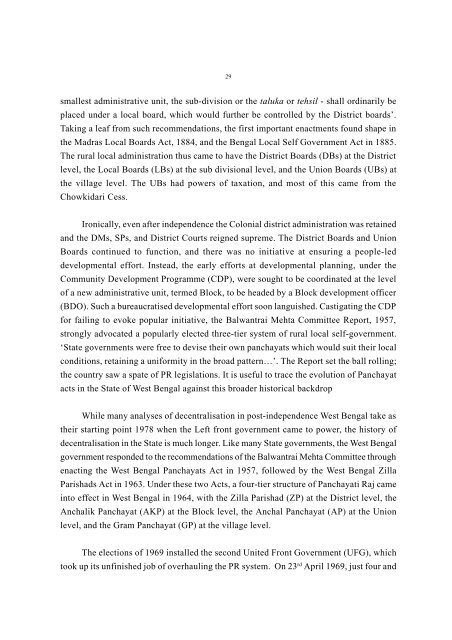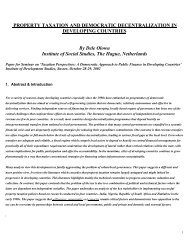View Article - Institute of Development Studies
View Article - Institute of Development Studies
View Article - Institute of Development Studies
Create successful ePaper yourself
Turn your PDF publications into a flip-book with our unique Google optimized e-Paper software.
29smallest administrative unit, the sub-division or the taluka or tehsil - shall ordinarily beplaced under a local board, which would further be controlled by the District boards’.Taking a leaf from such recommendations, the first important enactments found shape inthe Madras Local Boards Act, 1884, and the Bengal Local Self Government Act in 1885.The rural local administration thus came to have the District Boards (DBs) at the Districtlevel, the Local Boards (LBs) at the sub divisional level, and the Union Boards (UBs) atthe village level. The UBs had powers <strong>of</strong> taxation, and most <strong>of</strong> this came from theChowkidari Cess.Ironically, even after independence the Colonial district administration was retainedand the DMs, SPs, and District Courts reigned supreme. The District Boards and UnionBoards continued to function, and there was no initiative at ensuring a people-leddevelopmental effort. Instead, the early efforts at developmental planning, under theCommunity <strong>Development</strong> Programme (CDP), were sought to be coordinated at the level<strong>of</strong> a new administrative unit, termed Block, to be headed by a Block development <strong>of</strong>ficer(BDO). Such a bureaucratised developmental effort soon languished. Castigating the CDPfor failing to evoke popular initiative, the Balwantrai Mehta Committee Report, 1957,strongly advocated a popularly elected three-tier system <strong>of</strong> rural local self-government.‘State governments were free to devise their own panchayats which would suit their localconditions, retaining a uniformity in the broad pattern…’. The Report set the ball rolling;the country saw a spate <strong>of</strong> PR legislations. It is useful to trace the evolution <strong>of</strong> Panchayatacts in the State <strong>of</strong> West Bengal against this broader historical backdropWhile many analyses <strong>of</strong> decentralisation in post-independence West Bengal take astheir starting point 1978 when the Left front government came to power, the history <strong>of</strong>decentralisation in the State is much longer. Like many State governments, the West Bengalgovernment responded to the recommendations <strong>of</strong> the Balwantrai Mehta Committee throughenacting the West Bengal Panchayats Act in 1957, followed by the West Bengal ZillaParishads Act in 1963. Under these two Acts, a four-tier structure <strong>of</strong> Panchayati Raj cameinto effect in West Bengal in 1964, with the Zilla Parishad (ZP) at the District level, theAnchalik Panchayat (AKP) at the Block level, the Anchal Panchayat (AP) at the Unionlevel, and the Gram Panchayat (GP) at the village level.The elections <strong>of</strong> 1969 installed the second United Front Government (UFG), whichtook up its unfinished job <strong>of</strong> overhauling the PR system. On 23 rd April 1969, just four and





